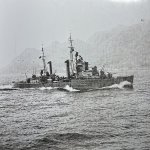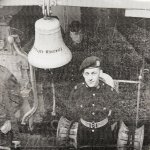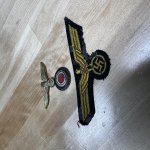You are using an out of date browser. It may not display this or other websites correctly.
You should upgrade or use an alternative browser.
You should upgrade or use an alternative browser.
Picture of the day
- Thread starter jwhc
- Start date
He started karaoke? Pretty sure he starred in Conan the barbarian as well? Lucrative career in Hollywood after that I think?
maple_leaf_eh
CGN Ultra frequent flyer
I'm not surprised by the large diameter fuselage of the parasite aircraft. The designers must have recognized any pilot who'd climb a ladder to his ride would need extra room for his testicles.
A interesting piece of Canadian history (note: this is Pre Conspiracy Theory and is recorded fact)
https://www.history.com/news/broken-arrow-first-lost-nuke-canada
Several B36s crashed in Canada, including another on Newfoundland, and one in Labrador.
https ://www.air-and-space.com/b-36%20wrecks.htm
A interesting piece of Canadian history (note: this is Pre Conspiracy Theory and is recorded fact)
https://www.history.com/news/broken-arrow-first-lost-nuke-canada
Apparently, bits of the plane are still there, some of the bomb fusing instruments were there until the US air force cleaned up. i could be wrong, but I think one of the bombs is still lying somewhere off the BC coast.
https://en.wikipedia.org/wiki/1950_British_Columbia_B-36_crash
Grizz
Always thought it was a fantastic plane!!
Remember building a plastic model of it when I was a kid.
Here's a 19' foot RC model.
Edit: the real one.
The Magnesium Overcast was very majestic, but what a carbon footprint.
Pictures and some back story from my Great Uncle of whom I’ve posted pictures in this thread before. Just dug this up last week, this letter was sent to his sister (my grandmother).

“HMS Dido leaving Scotland 1944”

“German Cruiser Nurnberg 1945”

He gave these to me 20 some odd years ago, said they came from his time aboard the Prinz Eugen and Nurnberg, of which there are more stories from his memoirs. If there is interest I’d be happy to share more.
In talking to you about the Russian Convoys, I realised it was a pity that we had no
photographs of those times - of course cameras were forbidden and as far as I know we
never had an ollicial war photographer aboard. To the best of my recollections now, I
joined H.M.S. Dido in the autumn of 1914 and our first job was to escort, with six
destroyers and two small pocket aircraft carriers (the converted 'banana boats' as we called
them), convoy No. JW61 from Scotland to Murmansk, then, after a couple of days there,
escorting Convoy RA61 (the empties!) on return to UK. The route went into the Arctic
Circle, around the North of Norway, and through the Kola Inlet into Murmansk. We were
of course prone to submarine attack throughout the journey, then attack by enemy aircraft
from the German arctic airbase at Hammerfest in North Norway - but the worst problem
sometimes was the weather - ice, snow and very heavy seas, - it was Winston Churchill who
described it as' the worst journey in the world'.
We then carried out quite a few operations against German shipping trying to get back to
Germany under cover of the Norwegian fjords and then escorted the big fleet carrier
Implacable' to carry out a concentrated attack on the German air base at Hammerfest,
when we encountered the worst storm of the war in the North Atlantic - we had to sit it out
for live days before they could get our aircraft off! (I think that was the worst trip of the lot)
Our last trip to Murmansk was in April 1945 with the mine-laying cruiser "'Apollo' and four
destroyers specially equipped with minelaying rails, to lay some 800 mines in the mouth of
the Kola Inlet where the U boats were making a practice of gathering in 'wolf packs' to
catch the ships - particularly stragglers from the convoys - on the last stages of their
journey down to Murmansk. I particularly remember this trip as we left the Kola Inlet on
24" April 1945 - my 19" birthday. Perhaps as a birthday present, the sea was as flat as a
millpond and the sun shone (It was the beginning of the Artic summer, but still bloody
cold) all the way back to Rosyth where we docked for a few days leave.
After the lads had been on leave for five days, we had an urgent recall of the ship's
company and we were on our way to Copenhagen to arrive on 8" May and take the
surrender of the last two active units of the German fleet -the heavy cruiser Prinz Eugen'
and the light cruiser 'Nurnberg.
After all the surrender formalities, I joined a liaison party comprised of our first lieutenant,
me as interpreter, and two signalmen to go aboard 'Nurnberg', which was to be escorted
with Prinz Eugen', by H.M.S. Dido and four destroyers to Wilhelmshaven, where
'Nurnberg' was to be handed over to the Russians and 'Prinz Eugen' to the U.S. Navy.
H.M.S. Dido then prepared to go out to the Far East and the Home Fleet finally left Scapa
Flow for Portland - then the Atomic bomb dropped on Japan and the whole situation was
drastically altered. H.M.S. Dido paid off the ship's company in April 1946 and I went
back to the Royal Marine Barracks at Chatham to await "demob'.
I enclose a few relevant photos of those times which you may find interesting.

“HMS Dido leaving Scotland 1944”

“German Cruiser Nurnberg 1945”

He gave these to me 20 some odd years ago, said they came from his time aboard the Prinz Eugen and Nurnberg, of which there are more stories from his memoirs. If there is interest I’d be happy to share more.
In talking to you about the Russian Convoys, I realised it was a pity that we had no
photographs of those times - of course cameras were forbidden and as far as I know we
never had an ollicial war photographer aboard. To the best of my recollections now, I
joined H.M.S. Dido in the autumn of 1914 and our first job was to escort, with six
destroyers and two small pocket aircraft carriers (the converted 'banana boats' as we called
them), convoy No. JW61 from Scotland to Murmansk, then, after a couple of days there,
escorting Convoy RA61 (the empties!) on return to UK. The route went into the Arctic
Circle, around the North of Norway, and through the Kola Inlet into Murmansk. We were
of course prone to submarine attack throughout the journey, then attack by enemy aircraft
from the German arctic airbase at Hammerfest in North Norway - but the worst problem
sometimes was the weather - ice, snow and very heavy seas, - it was Winston Churchill who
described it as' the worst journey in the world'.
We then carried out quite a few operations against German shipping trying to get back to
Germany under cover of the Norwegian fjords and then escorted the big fleet carrier
Implacable' to carry out a concentrated attack on the German air base at Hammerfest,
when we encountered the worst storm of the war in the North Atlantic - we had to sit it out
for live days before they could get our aircraft off! (I think that was the worst trip of the lot)
Our last trip to Murmansk was in April 1945 with the mine-laying cruiser "'Apollo' and four
destroyers specially equipped with minelaying rails, to lay some 800 mines in the mouth of
the Kola Inlet where the U boats were making a practice of gathering in 'wolf packs' to
catch the ships - particularly stragglers from the convoys - on the last stages of their
journey down to Murmansk. I particularly remember this trip as we left the Kola Inlet on
24" April 1945 - my 19" birthday. Perhaps as a birthday present, the sea was as flat as a
millpond and the sun shone (It was the beginning of the Artic summer, but still bloody
cold) all the way back to Rosyth where we docked for a few days leave.
After the lads had been on leave for five days, we had an urgent recall of the ship's
company and we were on our way to Copenhagen to arrive on 8" May and take the
surrender of the last two active units of the German fleet -the heavy cruiser Prinz Eugen'
and the light cruiser 'Nurnberg.
After all the surrender formalities, I joined a liaison party comprised of our first lieutenant,
me as interpreter, and two signalmen to go aboard 'Nurnberg', which was to be escorted
with Prinz Eugen', by H.M.S. Dido and four destroyers to Wilhelmshaven, where
'Nurnberg' was to be handed over to the Russians and 'Prinz Eugen' to the U.S. Navy.
H.M.S. Dido then prepared to go out to the Far East and the Home Fleet finally left Scapa
Flow for Portland - then the Atomic bomb dropped on Japan and the whole situation was
drastically altered. H.M.S. Dido paid off the ship's company in April 1946 and I went
back to the Royal Marine Barracks at Chatham to await "demob'.
I enclose a few relevant photos of those times which you may find interesting.
Attachments
maple_leaf_eh
CGN Ultra frequent flyer
<< B&W image of a 17-Pdr Sherman Firefly with extra track links welded to the glacis plate>>
A Sherman tank of The Canadian Grenadier Guards, Almelo, Netherlands, 5 April 1945.
In the Normandy campaign, Canadian crews learned their as-issued Shermans were mechanically reliable and on-par armed but not nearly well-enough protected against the variety of German anti-tank guns and AFVs. The smart officers encouraged them to protect themselves with salvaged tracks. Those tracks are all steel T62 pattern (http://the.shadock.free.fr/sherman_minutia/tracks/vvss_tracks.html). I am thinking about the fighting squadron commanders of the Sherbrooke Fusilier Regiment in particular. The rear echelon technical officers moaned about reducing the planned reliability of the tanks for the next many hundreds of miles. A real problem for the planners and logisticians, but the front line officers promptly ignored their orders claiming, 'A hundred miles! I worry about the next ten miles.'
I should get around to scanning some pictures from the CGG's " history book " Soldiers of the Queen, The Canadian Grenadier Guards of Montreal, 1859-2009
by BGEN( retired) William J. Patterson OMM, CD
499 pages.
http://www.journal.forces.gc.ca/vol10/no4/17-goodspeed-eng.asp
by BGEN( retired) William J. Patterson OMM, CD
499 pages.
http://www.journal.forces.gc.ca/vol10/no4/17-goodspeed-eng.asp
Anyone know what is hanging under this Anson?

Looks like an early iteration of the British ASV (Airborne Surface Vessel) Mk I radar.

































































































